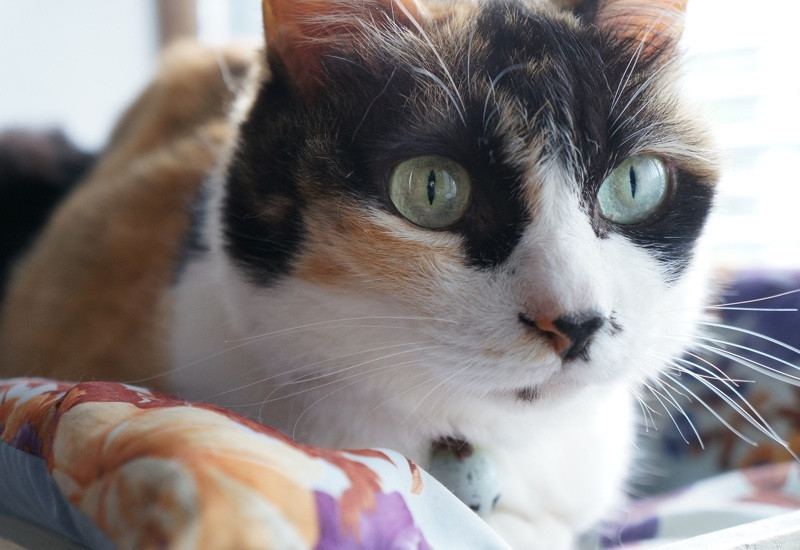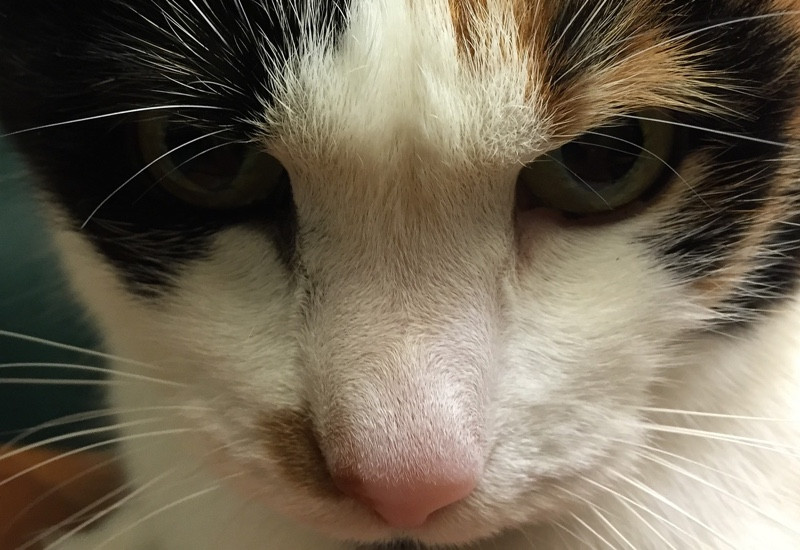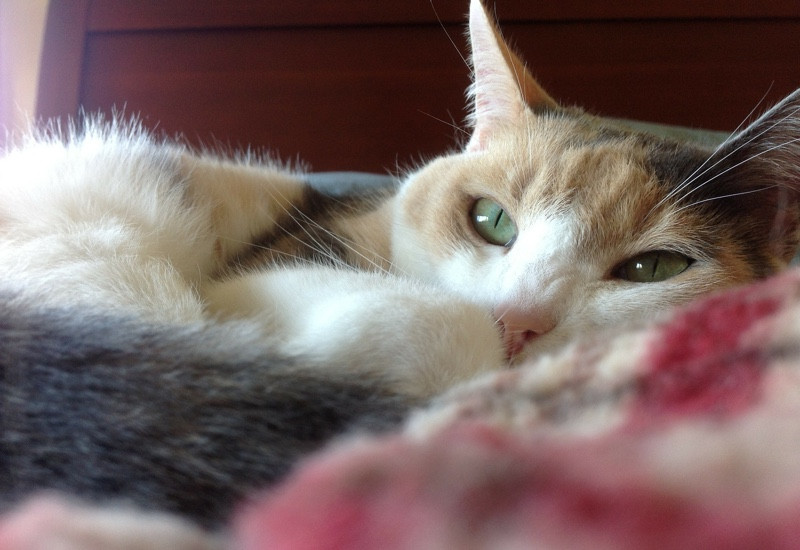Calico cats, with their distinctive and captivating coats, are instantly recognizable and adored by cat lovers worldwide. If you’ve ever wondered about these striking felines, you might have asked, “What Is A Calico Cat?” The answer is more than just a simple description of their fur – it delves into genetics, history, and even folklore. Let’s explore the fascinating world of calico cats and uncover what makes them so unique.
 A calico cat with striking green eyes sits comfortably on a plush cushion, showcasing its tri-color coat.
A calico cat with striking green eyes sits comfortably on a plush cushion, showcasing its tri-color coat.
Defining a Calico Cat: More Than Just a Breed
Firstly, it’s essential to understand that “calico” is not a breed of cat. Unlike breeds such as Persian, Siamese, or Maine Coon, the term “calico” refers specifically to a coat color pattern. You won’t find “Calico” on any official breed lists because it describes the coloring, not the cat’s lineage or breed-specific traits. Many different breeds can exhibit the calico pattern, including American Shorthairs, Japanese Bobtails, Persians, and more.
What truly defines a calico cat is its tri-color coat. To be classified as calico, a cat’s fur must feature three colors: white, black, and orange. These are the most basic calico colors, but variations are common. You might see cream instead of white, blue-black or grey instead of black, and reddish-brown or ginger instead of orange. These color variations broaden the spectrum of what we consider calico, making each calico cat’s coat a unique work of art.
It’s easy to confuse calico cats with tortoiseshell cats, often called “torties.” Both share black and orange coloring, but the key difference lies in the presence of white. Calico cats are predominantly white with distinct patches of orange and black (or their variations). Tortoiseshell cats, on the other hand, typically have a base coat of black and orange that is more mottled or brindled, with very little to no white fur. Think of calicos as having clear blocks of color on a white canvas, while torties are a more blended mix of darker shades.
 Close-up of a calico cat's face, highlighting the intricate patterns and colors in its fur.
Close-up of a calico cat's face, highlighting the intricate patterns and colors in its fur.
The Genetics Behind the Calico Coat: Why Mostly Female?
One of the most intriguing facts about calico cats is that they are overwhelmingly female. This is not just a coincidence; it’s deeply rooted in feline genetics and the way color is determined by chromosomes.
The genes responsible for orange and black coat colors are located on the X chromosome. Female cats, possessing two X chromosomes (XX), have the genetic capacity to carry both orange and black color genes. During early development, a process called X-chromosome inactivation occurs, where one of the X chromosomes in each cell is randomly deactivated. This means that in some cells, the X chromosome carrying the orange gene is active, and in others, the X chromosome carrying the black gene is active. The white color in calico cats is caused by a separate gene that masks the expression of colors, resulting in the distinct patches of color on a white background.
Male cats, with their XY chromosome combination, typically inherit only one X chromosome from their mother and a Y chromosome from their father. Therefore, they usually express only one color allele from their X chromosome – either black or orange, but not both in the calico pattern.
However, nature has its exceptions. In rare cases, a male cat can inherit an extra X chromosome, resulting in an XXY chromosome configuration. These cats are genetically male but possess the two X chromosomes needed to display the calico coloration. This genetic anomaly is associated with Klinefelter’s Syndrome in cats. These male calico cats are not only rare but are also almost always sterile, meaning they cannot reproduce.
Despite their sterility, it’s crucial to neuter male calico cats. Neutering provides significant health and behavioral benefits, including preventing testicular cancer and reducing unwanted territorial marking behaviors like spraying.
Origins and History of Calico Cats: A Global Traveler
The precise origin of calico cats remains a delightful mystery. However, genetic studies suggest that the calico pattern may have first emerged in Egypt. From there, these uniquely colored cats are believed to have journeyed along trade routes, possibly spreading through Mediterranean port cities in Italy, Spain, and France.
Today, calico cats are found across the globe, a testament to their adaptability and appeal. Whether basking in a sunny window in your home or gracing the streets of a bustling city, the calico cat’s striking appearance makes it a recognizable feline companion worldwide.
Calico Cat Personality: Myth vs. Reality
Is there a distinct “calico cat personality”? It’s important to remember that “calico” describes a coat color, not a breed. Therefore, a calico cat’s personality is primarily shaped by its breed and individual experiences, just like any other cat.
However, anecdotal evidence and folklore often associate certain personality traits with calico cats. Many owners describe their calicos as being particularly sweet, affectionate, and loyal companions. On the other hand, they are also often characterized as intelligent, independent, and even a bit feisty, with a reputation for quirky and unique behaviors.
Every cat is an individual, and personality is a complex mix of genetics, breed predispositions, upbringing, and environment. While it’s fun to consider the possibility of a “calico personality,” it’s more accurate to appreciate each calico cat for its own unique character.
For example, the author of the original article shares a personal anecdote about her calico cat’s unusual fascination with water, highlighting the individual quirks that make each cat so special.
Calico Cat Lifespan and Health: Understanding Potential Issues
The calico coat pattern itself does not directly influence a female cat’s lifespan. Generally, healthy female calico cats can live long and fulfilling lives, often reaching 15 years or more. Of course, individual lifespans vary depending on genetics, care, and overall health.
However, the situation can be different for the rare male calico cats. As mentioned earlier, their XXY chromosome makeup, associated with Klinefelter’s Syndrome, can lead to various health challenges that may impact their lifespan. Health problems linked to Klinefelter’s Syndrome in male calico cats can include:
- Cognitive and developmental issues: These can sometimes manifest as behavioral problems or learning difficulties.
- Reduced bone mineral content: This can increase the risk of bone fractures and osteoporosis.
- Increased body fat: This predisposition to obesity can lead to secondary health issues like joint pain, heart disease, and diabetes.
While Klinefelter’s Syndrome can present challenges, male calico cats with this condition can still live happy and loved lives, often with appropriate care and management of any health issues.
Caring for Your Calico Cat: Essential Tips
Caring for a female calico cat is essentially the same as caring for any cat. Regular brushing is beneficial to keep their colorful coat healthy and reduce shedding. Routine veterinary check-ups, vaccinations, and preventative care are crucial for maintaining their well-being.
Considering pet insurance is also a responsible step for any cat owner, including calico cat parents. Pet insurance can help manage the financial aspects of routine wellness care and provide a safety net for unexpected veterinary costs due to accidents or illnesses, ensuring your calico companion receives the best possible care throughout her life.
 A playful calico cat looking directly at the camera, with fun facts overlayed on the image.
A playful calico cat looking directly at the camera, with fun facts overlayed on the image.
Fun Facts About Calico Cats: More Than Just Pretty Coats
Beyond their striking appearance and genetic quirks, calico cats are rich in cultural associations and fun facts:
-
Stately Cats: The calico cat holds a special honor as the official state cat of Maryland, adopted in October 2001. Their colors mirror those of the Baltimore Oriole, Maryland’s state bird, and are proudly displayed by the Baltimore Orioles baseball team.
-
Good Luck Charms: In Japan, calico cats are considered symbols of good fortune. Historically, Japanese sailors often brought calico cats aboard ships to ward off bad luck and ensure safe voyages. In the United States and the United Kingdom, male calico cats are particularly seen as lucky due to their rarity.
-
The Beckoning Cat: The iconic Japanese “maneki-neko” or beckoning cat, often seen in businesses and homes, is frequently depicted as a calico cat. This symbol of good luck and prosperity dates back to the 1870s and continues to be a beloved cultural icon.
-
Mythical “Money Cats”: In the United States, calico cats were once nicknamed “Money Cats” with the misconception that they fetched high prices. However, this is a myth, especially considering male calico cats are sterile and not valuable for breeding purposes.
-
Folklore Remedies: Irish folklore suggests that calico cats possess wart-curing abilities. The tale claims that rubbing a wart against a calico cat’s tail can magically make it disappear. While not scientifically proven, it’s a charming example of the folklore surrounding these unique cats.
Naming Your Calico Cat: Inspiration and Ideas
If you are welcoming a calico cat into your home, choosing the perfect name is a delightful task. Calico cats offer a wealth of inspiration for names, drawing from their coat colors, history, or personality.
You might choose a name that reflects their autumnal colors, like Autumn, Amber, or Ginger. Names such as Patches, Speckles, or Motley capture their distinctive coat patterns. For a touch of history, Cleopatra or Lucky could be fitting choices. Or, if you want to reflect their personality, consider names like Sassy, Sweetie, or Harmony.
Here are some name ideas to get you started:
- Amber
- Amaretto
- Autumn
- Bella
- Butterscotch
- Calico
- Callie
- Camo
- Candy
- Cinnamon
- Cleo or Cleopatra
- Confetti
- Ginger
- Harmony
- Lucky
- Monarch
- Motley
- Oriole
- Patches
- Pebbles
- Penny
- Picasso
- Sassy
- Snickers
- Speckles
- Spice
- Spot
- Sunflower
- Sweetie
- Tiger
Calico cats are truly special felines, captivating us with their unique tri-color coats and intriguing genetic background. Whether you are already a proud calico cat parent or simply admire them from afar, their charm and mystique are undeniable.
*For further information, refer to The Cat Fancier’s Association list of cat breeds and details about Calico as Maryland’s State Cat.
